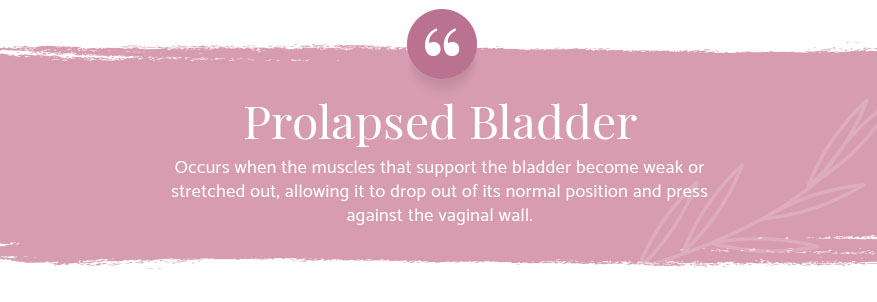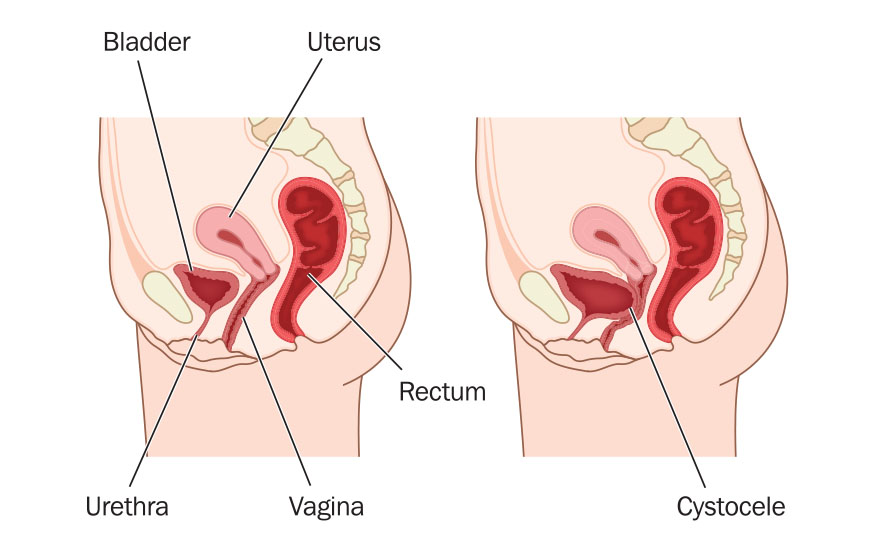7 Symptoms and Signs of Prolapsed Bladder
If you feel like your bladder is falling out of your body, you could have a surprisingly common yet often overlooked condition known as bladder prolapse (cystocele). While it doesn’t actually put you at risk of losing your bladder — trust us, we checked with the experts — the ailment can cause a whole host of uncomfortable side effects that shouldn’t be ignored. In this guide, we’re going over the most common signs and symptoms of prolapsed bladder to help you manage diagnosis and treatment.

At a Glance: Symptoms of Prolapsed Bladder
A bulge at the opening of the vagina
A feeling of heaviness in the vagina
Urinary incontinence and urgency
Pain in the lower back, abdomen, or pelvic region
Pain during intercourse or when wearing a tampon
Bleeding of the vaginal tissue
Trouble with bowel movements
What Is a Prolapsed Bladder?
Prolapsed bladder occurs when the muscles that support the bladder become weak or stretched out, allowing it to drop out of its normal position and press against the vaginal wall.

According to Dr. Jessica Drummond, the CEO of The Integrative Women’s Health Institute, a prolapsed bladder actually refers to a condition known as “anterior vaginal wall weakness” and it happens when the pelvic floor muscles become so weak that the bladder pushes into the vagina. “The bladder can push into the vaginal canal — not breaking the anterior vaginal wall — and press into the opening of the vagina,” says Dr. Drummond. “It is caused by weakness in the pelvic floor muscles and the fascia and ligaments that support the bladder.”

This structural weakness happens when the pelvic muscles are put under too much pressure and strain. Pregnancy, childbirth, coughing, jumping, heavy lifting, straining with constipation, and general aging are a few of the things that can weaken the pelvic floor and contribute to prolapse. And since these are things that pretty much everyone experiences on occasion, it’s not surprising to learn that prolapsed bladder is quite common, affecting about 50 percent of women.
Predictably, the condition is common among women who have given birth. But not so predictably, it’s also prevalent in young athletes who play sports involving heavy landings, jumping, or lifting. Therefore, it should not be dismissed as a diagnosis based on age.
Most Common Symptoms of a Prolapsed Bladder
A Bulge at the Opening of the Vagina
The condition can cause a visual bulge at the opening of the vagina, which some women describe as the feeling of a tampon that’s not fully inserted or feeling like you’re constantly sitting on a small ball.
“The vagina can lose support and start to ‘drop’ or herniate outside of the vagina and cause vaginal bulge symptoms,” says Dr. Leslie M. Rickey, MD, a Yale Medicine female pelvic medicine and reconstructive surgeon and associate professor of Urology, Obstetrics, Gynecology, and Reproductive Sciences at Yale School of Medicine.
Vaginal bulge is one of the most common and worrying symptoms associated with the condition. However, Dr. Rickey says that a vaginal bulge alone should not always be cause for alarm, but if it becomes bothersome to you or you experience other pelvic floor symptoms along with it, then you should seek out treatment from a specialist.
A Feeling of Heaviness in the Vagina
Another of the earliest and most telling signs of prolapsed bladder is a feeling of heaviness or pressure near the opening of the vagina. Not surprisingly, there’s a simple explanation for this phenomenon — gravity. If the front part of the vagina is prolapsed, the bladder can start to lose support from the pelvic floor muscles, which allows it to drop. This is what causes that hallmark feeling of heaviness in the pelvic region.
Urinary Incontinence and Urgency
If you start to feel a bulging pressure in the vagina, pay close attention to your urinary patterns. Your bladder will sound a few alarm bells to let you know something’s off. “Sometimes prolapse can be associated with difficulty with urination or urinary urgency and frequent urination,” says Dr. Rickey.
Typically, bladder prolapse is associated with bladder leakage due to stress incontinence, which is caused by pressure put on the organ from exercising, coughing, or sneezing. In addition, prolapse can cause you to feel like your bladder is not completely empty right after urinating. It may also contribute to frequent bladder infections.
Keeping incontinence liners on hand can help you manage these symptoms until you seek out treatment from a specialist, if needed.
Other Symptoms of Bladder Prolapse
Unfortunately, cystocele doesn’t stop at bulging or urinary issues. Though all of these symptoms can and often do appear independently of one another, when multiple occur at the same time, it may suggest cystocele.

- Pain and discomfort in the lower back, abdomen, or pelvic region. The pain tends to worsen throughout the day or when standing, coughing, or lifting.
- Pain during intercourse and the inability to wear a tampon. Prolapse can cause vaginal tissues to feel tender, which can make penetration painful. Some women also experience a feeling of numbness during sex.
- Bleeding of the vaginal tissue. Protruding tissue can become irritated throughout the day and cause bleeding.
- Trouble having regular bowel movements. A weakened pelvic floor can also contribute to bowel incontinence and straining.
It’s also important to note that some women don’t experience any symptoms at all. Dr. Drummond notes that signs may not be apparent until a patient is being examined in a medical setting. “On a pelvic exam, a gynecologist or pelvic physical therapist can see the bladder dropping down into the vaginal canal with pressure,” she says.
Treating a Prolapsed Bladder
Treatment Options for Bladder Prolapse
Pelvic floor physical therapy and muscle exercises
Cystocele repair surgery
The use of a pessary device

Treatment of a prolapsed bladder ranges widely from conservative interventions like pelvic floor exercises (Kegels) to cystocele repair surgery, which is often reserved for cases of severe bladder prolapse. Many women are able to drastically improve the state of prolapse with pelvic floor muscle training administered by a pelvic floor physical therapist. Others may find success with the use of a pessary, a removable device that fits into the vagina to support the bladder.
If you are experiencing one or more of these symptoms and believe you may have a prolapsed bladder, it’s important that you speak to your physician about it as soon as possible. Dr. Rickey recommends seeking a referral for a doctor specializing in female pelvic medicine, pelvic reconstructive surgery, or urogynecology.
“This type of specialist can evaluate all of these symptoms and do a careful assessment of your pelvic floor to come up with an individualized treatment plan to help improve your quality of life,” says Dr. Rickey. Specialists use a grading system of one to four (mild to complete) to determine the right treatment course.
In addition to medical intervention and therapy, Dr. Drummond recommends making some lifestyle changes as part of a well-rounded treatment plan. “Prolapse is best treated in collaboration with a nutritionist to optimize urinary health, hydration, and digestive health, especially with bladder symptoms like incontinence, urgency, or frequency,” she says.
Your Partner in Incontinence
At Sofia & Grace, we’re not just your go-to supplier of incontinence products for women. We’re a trusted friend and resource here to help you navigate everything life throws your way, bladder prolapse and beyond. Whether you’re experiencing bladder leakage due to prolapse, aging, pregnancy, or anything else, we’re here to arm you with the supplies and knowledge needed to conquer it with grace.
Shop All Sofia & Grace Incontinence Products
Image Credits
My Ocean Production / Shutterstock.com
Blamb / Shutterstock.com
gpointstudio / Shutterstock.com
